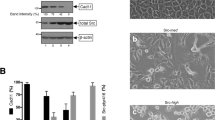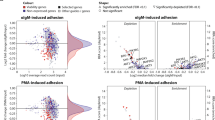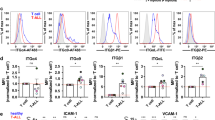Abstract
The Ras family small GTPase Rap1 is activated by hematopoietic cytokines, such as interleukin (IL)-3, to induce β1 integrin-mediated cell adhesion or by the BCR/ABL fusion tyrosine kinase to stimulate the MEK/Erk signaling pathway. Here, we demonstrate that the abrogation of Rap1 activation by SPA-1, a Rap1-specific GAP, inhibits activation of B-Raf, MEK, Erk, and Akt in a murine hematopoietic cell line, Ton.B210, stimulated with IL-3 or inducibly expressing BCR/ABL. Furthermore, Rap1 inactivation had an inhibitory effects on proliferation and survival of Ton.B210 cells, which were more remarkable when cells were stimulated by BCR/ABL than by IL-3. Induction of BCR/ABL expression increased adhesion of Ton.B210 cells to fibronectin in a manner at least partly dependent on its kinase activity, and Rap1 inhibition by SPA-1 partially inhibited BCR/ABL-induced adhesion of cells. Thus, IL-3- or BCR/ABL-induced activation of Rap1 may play important roles in regulation of cell proliferation and survival through activation of the B-Raf/MEK/Erk and Akt signaling pathways and in induction of integrin-mediated cell adhesion. Furthermore, as compared with IL-3, BCR/ABL is more dependent on Rap1-mediated signaling to induce cell proliferation and survival and, thus, Rap1 may represent an attractive target for novel therapies for leukemias caused by BCR/ABL.
This is a preview of subscription content, access via your institution
Access options
Subscribe to this journal
Receive 50 print issues and online access
$259.00 per year
only $5.18 per issue
Buy this article
- Purchase on Springer Link
- Instant access to full article PDF
Prices may be subject to local taxes which are calculated during checkout





Similar content being viewed by others
References
Arai A, Nosaka Y, Kanda E, Yamamoto K, Miyasaka N, Miura O . (2001). J Biol Chem 276: 10453–10462.
Arai A, Nosaka Y, Kohsaka H, Miyasaka N, Miura O . (1999). Blood 93: 3713–3722.
Barnes DJ, Schultheis B, Adedeji S, Melo JV . (2005). Oncogene 24: 6432–6440.
Bar-Sagi D, Hall A . (2000). Cell 103: 227–238.
Bazzoni G, Carlesso N, Griffin JD, Hemler ME . (1996). J Clin Invest 98: 521–528.
Bhatia R, Munthe HA, Forman SJ . (2001). Br J Haematol 115: 845–853.
Bondzi C, Grant S, Krystal GW . (2000). Oncogene 19: 5030–5033.
Bos JL, de Rooij J, Reedquist KA . (2001). Nat Rev Mol Cell Biol 2: 369–377.
Brazil DP, Yang ZZ, Hemmings BA . (2004). Trends Biochem Sci 29: 233–242.
Brummer T, Shaw PE, Reth M, Misawa Y . (2002). EMBO J 21: 5611–5622.
Christian SL, Lee RL, McLeod SJ, Burgess AE, Li AH, Dang-Lawson M et al. (2003). J Biol Chem 278: 41756–41767.
Clarkson B, Strife A, Wisniewski D, Lambek CL, Liu C . (2003). Leukemia 17: 1211–1262.
Downward J . (1997). Adv Second Messenger Phosphoprotein Res 31: 1–10.
Faderl S, Talpaz M, Estrov Z, O'Brien S, Kurzrock R, Kantarjian HM . (1999). N Engl J Med 341: 164–172.
Garcia J, de Gunzburg J, Eychene A, Gisselbrecht S, Porteu F . (2001). Mol Cell Biol 21: 2659–2670.
Goldman JM, Melo JV . (2003). N Engl J Med 349: 1451–1464.
Gordon MY, Dowding CR, Riley GP, Goldman JM, Greaves MF . (1987). Nature 328: 342–344.
Hattori M, Minato N . (2003). J Biochem (Tokyo) 134: 479–484.
Ihle JN . (1995). Nature 377: 591–594.
Ishida D, Kometani K, Yang H, Kakugawa K, Masuda K, Iwai K et al. (2003). Cancer Cell 4: 55–65.
Kitayama H, Sugimoto Y, Matsuzaki T, Ikawa Y, Noda M . (1989). Cell 56: 77–84.
Klein S, McCormick F, Levitzki A . (2005). Nat Rev Cancer 5: 573–580.
Klejman A, Rushen L, Morrione A, Slupianek A, Skorski T . (2002). Oncogene 21: 5868–5876.
Klucher KM, Lopez DV, Daley GQ . (1998). Blood 91: 3927–3934.
Kometani K, Ishida D, Hattori M, Minato N . (2004). Trends Mol Med 10: 401–408.
Kramer A, Horner S, Willer A, Fruehauf S, Hochhaus A, Hallek M et al. (1999). Proc Natl Acad Sci USA 96: 2087–2092.
Kurachi H, Wada Y, Tsukamoto N, Maeda M, Kubota H, Hattori M et al. (1997). J Biol Chem 272: 28081–28088.
Lou L, Urbani J, Ribeiro-Neto F, Altschuler DL . (2002). J Biol Chem 277: 32799–32806.
Marley SB, Lewis JL, Schneider H, Rudd CE, Gordon MY . (2004). Br J Haematol 125: 500–511.
Miura O, Cleveland JL, Ihle JN . (1993). Mol Cell Biol 13: 1788–1795.
Miura O, Nakamura N, Ihle JN, Aoki N . (1994). J Biol Chem 269: 614–620.
Mizuchi D, Kurosu T, Kida A, Jin ZH, Jin A, Arai A et al. (2005). Biochem Biophys Res Commun 326: 645–651.
Papin C, Denouel A, Calothy G, Eychene A . (1996). Oncogene 12: 2213–2221.
Pizon V, Chardin P, Lerosey I, Olofsson B, Tavitian A . (1988). Oncogene 3: 201–204.
Ramaraj P, Singh H, Niu N, Chu S, Holtz M, Yee JK et al. (2004). Cancer Res 64: 5322–5331.
Skorski T, Kanakaraj P, Nieborowska-Skorska M, Ratajczak MZ, Wen SC, Zon G et al. (1995). Blood 86: 726–736.
Stork PJ . (2003). Trends Biochem Sci 28: 267–275.
Stork PJ, Dillon TJ . (2005). Blood 106: 2952–2961.
Takai Y, Sasaki T, Matozaki T . (2001). Physiol Rev 81: 153–208.
Tsukamoto N, Hattori M, Yang H, Bos JL, Minato N . (1999). J Biol Chem 274: 18463–18469.
Tsygankova OM, Saavedra A, Rebhun JF, Quilliam LA, Meinkoth JL . (2001). Mol Cell Biol 21: 1921–1929.
van den Berghe N, Cool RH, Horn G, Wittinghofer A . (1997). Oncogene 15: 845–850.
Verfaillie CM, McCarthy JB, McGlave PB . (1992). J Clin Invest 90: 1232–1241.
Wang L, Liu F, Adamo ML . (2001). J Biol Chem 276: 37242–37249.
Wellbrock C, Karasarides M, Marais R . (2004). Nat Rev Mol Cell Biol 5: 875–885.
Wertheim JA, Forsythe K, Druker BJ, Hammer D, Boettiger D, Pear WS . (2002). Blood 99: 4122–4130.
Wertheim JA, Perera SA, Hammer DA, Ren R, Boettiger D, Pear WS . (2003). Blood 102: 2220–2228.
Acknowledgements
We are grateful to Drs George Q Daley, and Johannes L Bos for the generous gifts of experimental materials. This study was supported in part by grants from Ministry of Education, Culture, Sports, Science and Technology of Japan.
Author information
Authors and Affiliations
Corresponding author
Rights and permissions
About this article
Cite this article
Jin, A., Kurosu, T., Tsuji, K. et al. BCR/ABL and IL-3 activate Rap1 to stimulate the B-Raf/MEK/Erk and Akt signaling pathways and to regulate proliferation, apoptosis, and adhesion. Oncogene 25, 4332–4340 (2006). https://doi.org/10.1038/sj.onc.1209459
Received:
Revised:
Accepted:
Published:
Issue Date:
DOI: https://doi.org/10.1038/sj.onc.1209459
Keywords
This article is cited by
-
The Philadelphia chromosome in leukemogenesis
Chinese Journal of Cancer (2016)
-
Sprouty1, a new target of the angiostatic agent 16K prolactin, negatively regulates angiogenesis
Molecular Cancer (2010)
-
Rottlerin synergistically enhances imatinib-induced apoptosis of BCR/ABL-expressing cells through its mitochondrial uncoupling effect independent of protein kinase C-δ
Oncogene (2007)
-
Modulation of mast cell proteinase‐activated receptor expression and IL‐4 release by IL‐12
Immunology & Cell Biology (2007)



